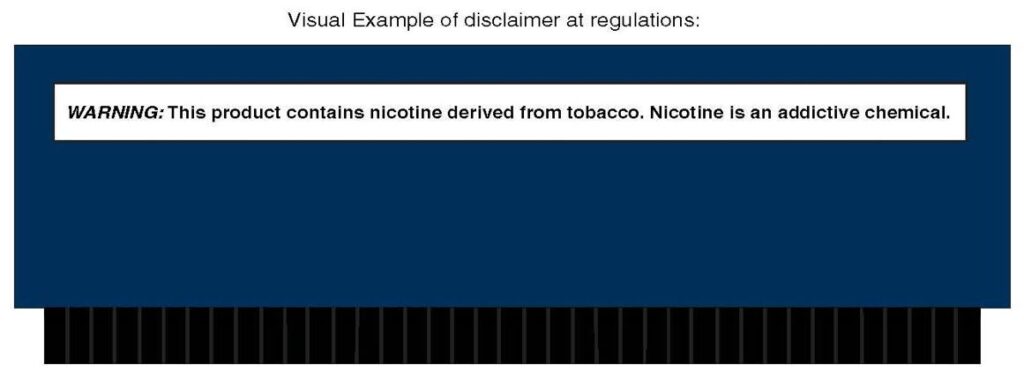
Advertising for electronic cigarettes that deliver nicotine via vapor is a growing category for out of home advertising. Effective August 10, ads for e-cigarettes must include a warning that nicotine is addictive. New rules from the Food & Drug Administration (FDA) require the warning to occupy 20 percent of the ad space. OAAA attorney Kerry Yoakum explains this new requirement and what it means for OOH ads. Advertising for electronic cigarettes that deliver nicotine via vapor is a growing category for out of home advertising. Effective August 10, ads for e-cigarettes must include a warning that nicotine is addictive. New rules from the Food & Drug Administration (FDA) require the warning to occupy 20 percent of the ad space. OAAA attorney Kerry Yoakum explains this new requirement and what it means for OOH ads.
Since 2009, under the Tobacco Control Act, the US Food and Drug Administration (FDA) has regulated cigarettes, smokeless, and roll-your-own tobacco. A recent rule, affectionately called the “Deeming Tobacco Products to be Subject to the Federal Food, Drug and Cosmetic Act, as Amended by the Family Smoking Prevention and Tobacco Control Act” (aka the Deeming rule) extends FDA’s regulatory authority to “deem” other “tobacco products” subject to its regulation, too. Under the act, a “tobacco product” is:
… any product made or derived from tobacco that is intended for human consumption, including any component, part, or accessory of a tobacco product (except for raw materials other than tobacco used in manufacturing a component, part, or accessory of a tobacco product).
With its “deeming rule,” the FDA has effectively declared e-cigarettes and other forms of electronic nicotine delivery systems (ENDS), in addition to their parts and components, to be subject to regulation under the Tobacco Act.
The deeming rule also requires that advertisements, including billboards, for all covered tobacco products bear an addictiveness warning statement. Effective August 10, 2018, the tobacco product advertisement must bear the following required warning label statement: “WARNING: This product contains nicotine. Nicotine is an addictive chemical.”

It should be noted that these regulations cover e-cigarettes and electronic nicotine delivery products. Accordingly, an advertisement for a vaping store would not be required to include the warning label, unless the advertisement also includes a brand advertisement.

These advertising requirements for all covered tobacco products, except cigars, which are found in a different section of the Code of Federal Regulations (CFR), are found in 21 CFR 1143.3, which further set forth requirements with respect to font, text, size, placement, and formatting of the warning statements in the advertisements. The mock-up of a bulletin above was created to conform to these standards, which provide the required warning statement must:
- Appear in the upper portion of the area of the advertisement
- Occupy at least 20 percent of the area of the advertisement
- Be printed in at least 12-point font and a font size that ensures that the text occupies the greatest possible proportion of the warning area set aside for the text required
- Appear in Helvetica bond or Arial bold type in black on white background or white on black background in a manner that contrasts by typography, layout or color, with other printed material on the advertisement
- Be capitalized and punctuated as shown in the example above
- Be centered within the rectangular border and be positioned such that the text of the required warning statement and other textual information in the advertisement have the same orientation
- Be surrounded by a rectangular border that is the same color as the text of the required warning statement and that is not less than 3 millimeters (mm) or more than 4 millimeters (mm).
In a case styled Nicopure Labs, LLC v. FDA, e-cigarette retailers and associations challenged the FDA’s deeming rule on several grounds. Among other things, they alleged that the rule exceeded the FDA’s authority under the Family Smoking Prevention and Tobacco Control Act (“Tobacco Act”), violated the First Amendment, and was arbitrary and capricious. Although the federal district court explicitly found that the deeming rule constitutes a “clear restriction on truthful and non-misleading speech,” it nonetheless upheld the rule under an unusually relaxed application of the Central Hudson test. This decision has been appealed to the US District Court of Appeals in Washington, DC, briefed by the parties and amici, and is awaiting a date for oral arguments.
At this point, it appears unlikely that a final determination will be made by the effective date, so be prepared to implement these requirements on August 10, 2018.
Published: July 16, 2018